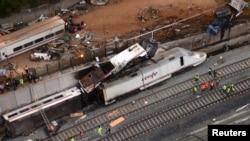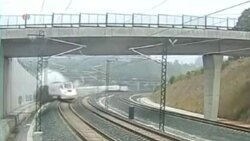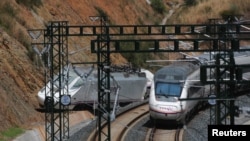SANTIAGO DE COMPOSTELA —
Police took the driver of a Spanish train into custody in hospital on Thursday after at least 78 people died when it derailed and caught fire in a dramatic accident which an official source said was caused by excessive speed.
The eight-car high velocity train came off the tracks just outside the pilgrimage center of Santiago de Compostela in northwestern Spain on Wednesday night. It was one of Europe's worst rail disasters.
The source had knowledge of the official investigation into a crash which brought misery to Santiago on Thursday, the day when it should have celebrated one of Europe's biggest Christian festivals. Authorities canceled festivities as the city went into mourning.
The Galicia region supreme court said in a statement that the judge investigating the accident had ordered police to put the driver in custody and take a statement from him. He was under formal investigation, the court said.
Dramatic video footage from a security camera showed the train, with 247 people on board, hurtling into a concrete wall at the side of the track as carriages jack-knifed and the engine overturned.
Watch video footage of the derailment
One local official described the aftermath of the crash as like a scene from hell, with bodies strewn next to the tracks.
The impact was so huge one car flew several meters into the air and landed on the other side of the high concrete barrier.
Some 94 people were injured, of whom 35 were in a serious condition, including four children, the deputy head of the regional government said.
“We heard a massive noise and we went down the tracks. I helped get a few injured and bodies out of the train. I went into one of the cars but I'd rather not tell you what I saw there,” Ricardo Martinez, a 47-year-old baker from Santiago de Compostela, told Reuters.
The train had two drivers, the Galicia government said, but it was not immediately clear which one was in hospital and under investigation.
Newspaper accounts cited witnesses as saying one driver, Francisco Jose Garzon, who had helped rescue victims, shouted into a phone: “I've derailed! What do I do?”.
The 52-year-old had been a train driver for 30 years, a Renfe spokeswoman said. Many newspapers published excerpts from his Facebook account where he was reported to have boasted of driving trains at high speed. The page was taken offline on Thursday and the reports could not be verified.
Train hit bend at speed
El Pais newspaper said one of the drivers told the railway station by radio after being trapped in his cabin that the train entered the bend at 190 kilometers per hour (120 mph). An official source said the speed limit on that stretch of twin track, laid in 2011, was 80 kph.
“We're only human! We're only human!” the driver told the station, the newspaper said, citing sources close to the investigation. “I hope there are no dead, because this will fall on my conscience.”
Investigators were trying to urgently establish why the train was going so fast and why security devices to keep speed within permitted limits had not worked.
The train, operated by state-owned company Renfe, was built by Bombardier and Talgo and was around five years old. It had almost the maximum number of passengers.
Spain's rail safety record is better than the European average, ranking 18th out of 27 countries in terms of railway deaths per kilometers traveled, the European Railway Agency said. There were 218 train accidents in Spain between 2008-2011, well below the European Union average of 426 for the same period, the agency said.
Eve of festival
Firefighters called off a strike to help with the disaster, while hospital staff, many operating on reduced salaries because of spending cuts in recession-hit Spain, worked overtime to tend the injured.
The disaster happened at 8.41 p.m. (1841 GMT) on the eve of a festival dedicated to St. James, one of Jesus's 12 disciples, whose remains are said to rest in the city's centuries-old cathedral.
The apostle's shrine is the destination of the famous El Camino de Santiago pilgrimage across the Pyrenees, which has been followed by Christians since the Middle Ages.
Instead of a joyous festival, masses were held every hour in the cathedral. “The main mass was transformed from a mass of joy into a mass of mourning,” said Italian pilgrim Irene Valsangiacomo.
One U.S. citizen died in the crash and five were injured, the State Department said in Washington. Mexico said one of its nationals was among the dead.
At least one British citizen was injured, a British embassy spokesman said. Several other nationalities were believed to be among the passengers.
Neighbors ran to the site to help emergency workers tend to the wounded. Ana Taboada, a 29-year-old hospital worker, was one of the first on the scene.
“When the dust lifted I saw corpses. I didn't make it down to the track, because I was helping the passengers that were coming up the embankment,” she told Reuters. “I saw a man trying to break a window with a stone to help those inside get out.”
Prime Minister Mariano Rajoy, who was born in Santiago de Compostela, the capital of Galicia region, visited the site and the main hospital on Thursday. He declared three days of official national mourning for the victims of the disaster.
King Juan Carlos and Queen Sofia also went to Santiago and visited the injured in hospital.
Passenger Ricardo Montesco told Cadena Ser radio station the train approached the curve at high speed, twisted and the carriages piled up one on top of the other.
Passengers squashed
“A lot of people were squashed on the bottom. We tried to squeeze out of the bottom of the wagons to get out and we realized the train was burning. ... I was in the second carriage and there was fire. ... I saw corpses,” he said.
Both Renfe and state-owned Adif, which is in charge of the tracks, had opened an investigation into the cause of the derailment, Renfe said.
Clinics in Santiago de Compostela were overwhelmed with people flocking to give blood, while hotels organized free rooms for relatives. Madrid sent forensic scientists and hospital staff to the scene on special flights.
The train was traveling from Madrid to Ferrol on the Galician coast when it derailed, Renfe said in a statement. It left Madrid on time and was traveling on schedule, a spokeswoman said.
Allianz Seguros, owned by Germany's Allianz, owns the insurance contract for loss suffered by Renfe passengers, a company spokeswoman told Reuters. The contract does not cover Renfe's trains. The company had sent experts to the scene, she said.
The disaster stirred memories of a train bombing in Madrid in 2004, carried out by Islamist militants, that killed 191 people, although officials do not suspect an attack this time.
Spain is struggling to emerge from a long-running recession marked by government-driven austerity to bring its deeply indebted finances into order.
But Adif, the state railways infrastructure company, told Reuters no budget cuts had been implemented on maintenance of the line, which connects La Coruna, Santiago de Compostela and Ourense and was inaugurated in 2011.
It said more than 100 million euros a year were being spent on track maintenance in Spain.
Wednesday's derailment was one of the worst rail accidents in Europe over the past 25 years.
Note: An earlier version of this story reported that the death toll in the train crash was 80. The toll was provisionally revised down to 78.
The eight-car high velocity train came off the tracks just outside the pilgrimage center of Santiago de Compostela in northwestern Spain on Wednesday night. It was one of Europe's worst rail disasters.
The source had knowledge of the official investigation into a crash which brought misery to Santiago on Thursday, the day when it should have celebrated one of Europe's biggest Christian festivals. Authorities canceled festivities as the city went into mourning.
The Galicia region supreme court said in a statement that the judge investigating the accident had ordered police to put the driver in custody and take a statement from him. He was under formal investigation, the court said.
Dramatic video footage from a security camera showed the train, with 247 people on board, hurtling into a concrete wall at the side of the track as carriages jack-knifed and the engine overturned.
Watch video footage of the derailment
One local official described the aftermath of the crash as like a scene from hell, with bodies strewn next to the tracks.
The impact was so huge one car flew several meters into the air and landed on the other side of the high concrete barrier.
Some 94 people were injured, of whom 35 were in a serious condition, including four children, the deputy head of the regional government said.
“We heard a massive noise and we went down the tracks. I helped get a few injured and bodies out of the train. I went into one of the cars but I'd rather not tell you what I saw there,” Ricardo Martinez, a 47-year-old baker from Santiago de Compostela, told Reuters.
The train had two drivers, the Galicia government said, but it was not immediately clear which one was in hospital and under investigation.
Newspaper accounts cited witnesses as saying one driver, Francisco Jose Garzon, who had helped rescue victims, shouted into a phone: “I've derailed! What do I do?”.
The 52-year-old had been a train driver for 30 years, a Renfe spokeswoman said. Many newspapers published excerpts from his Facebook account where he was reported to have boasted of driving trains at high speed. The page was taken offline on Thursday and the reports could not be verified.
Train hit bend at speed
El Pais newspaper said one of the drivers told the railway station by radio after being trapped in his cabin that the train entered the bend at 190 kilometers per hour (120 mph). An official source said the speed limit on that stretch of twin track, laid in 2011, was 80 kph.
“We're only human! We're only human!” the driver told the station, the newspaper said, citing sources close to the investigation. “I hope there are no dead, because this will fall on my conscience.”
Investigators were trying to urgently establish why the train was going so fast and why security devices to keep speed within permitted limits had not worked.
The train, operated by state-owned company Renfe, was built by Bombardier and Talgo and was around five years old. It had almost the maximum number of passengers.
Spain's rail safety record is better than the European average, ranking 18th out of 27 countries in terms of railway deaths per kilometers traveled, the European Railway Agency said. There were 218 train accidents in Spain between 2008-2011, well below the European Union average of 426 for the same period, the agency said.
Eve of festival
Firefighters called off a strike to help with the disaster, while hospital staff, many operating on reduced salaries because of spending cuts in recession-hit Spain, worked overtime to tend the injured.
The disaster happened at 8.41 p.m. (1841 GMT) on the eve of a festival dedicated to St. James, one of Jesus's 12 disciples, whose remains are said to rest in the city's centuries-old cathedral.
The apostle's shrine is the destination of the famous El Camino de Santiago pilgrimage across the Pyrenees, which has been followed by Christians since the Middle Ages.
Instead of a joyous festival, masses were held every hour in the cathedral. “The main mass was transformed from a mass of joy into a mass of mourning,” said Italian pilgrim Irene Valsangiacomo.
One U.S. citizen died in the crash and five were injured, the State Department said in Washington. Mexico said one of its nationals was among the dead.
At least one British citizen was injured, a British embassy spokesman said. Several other nationalities were believed to be among the passengers.
Neighbors ran to the site to help emergency workers tend to the wounded. Ana Taboada, a 29-year-old hospital worker, was one of the first on the scene.
“When the dust lifted I saw corpses. I didn't make it down to the track, because I was helping the passengers that were coming up the embankment,” she told Reuters. “I saw a man trying to break a window with a stone to help those inside get out.”
Prime Minister Mariano Rajoy, who was born in Santiago de Compostela, the capital of Galicia region, visited the site and the main hospital on Thursday. He declared three days of official national mourning for the victims of the disaster.
King Juan Carlos and Queen Sofia also went to Santiago and visited the injured in hospital.
Passenger Ricardo Montesco told Cadena Ser radio station the train approached the curve at high speed, twisted and the carriages piled up one on top of the other.
Passengers squashed
“A lot of people were squashed on the bottom. We tried to squeeze out of the bottom of the wagons to get out and we realized the train was burning. ... I was in the second carriage and there was fire. ... I saw corpses,” he said.
Both Renfe and state-owned Adif, which is in charge of the tracks, had opened an investigation into the cause of the derailment, Renfe said.
Clinics in Santiago de Compostela were overwhelmed with people flocking to give blood, while hotels organized free rooms for relatives. Madrid sent forensic scientists and hospital staff to the scene on special flights.
The train was traveling from Madrid to Ferrol on the Galician coast when it derailed, Renfe said in a statement. It left Madrid on time and was traveling on schedule, a spokeswoman said.
Allianz Seguros, owned by Germany's Allianz, owns the insurance contract for loss suffered by Renfe passengers, a company spokeswoman told Reuters. The contract does not cover Renfe's trains. The company had sent experts to the scene, she said.
The disaster stirred memories of a train bombing in Madrid in 2004, carried out by Islamist militants, that killed 191 people, although officials do not suspect an attack this time.
Spain is struggling to emerge from a long-running recession marked by government-driven austerity to bring its deeply indebted finances into order.
But Adif, the state railways infrastructure company, told Reuters no budget cuts had been implemented on maintenance of the line, which connects La Coruna, Santiago de Compostela and Ourense and was inaugurated in 2011.
It said more than 100 million euros a year were being spent on track maintenance in Spain.
Wednesday's derailment was one of the worst rail accidents in Europe over the past 25 years.
Note: An earlier version of this story reported that the death toll in the train crash was 80. The toll was provisionally revised down to 78.













